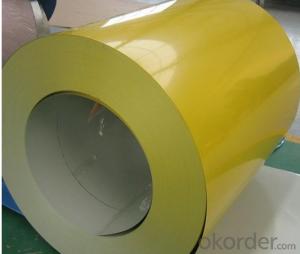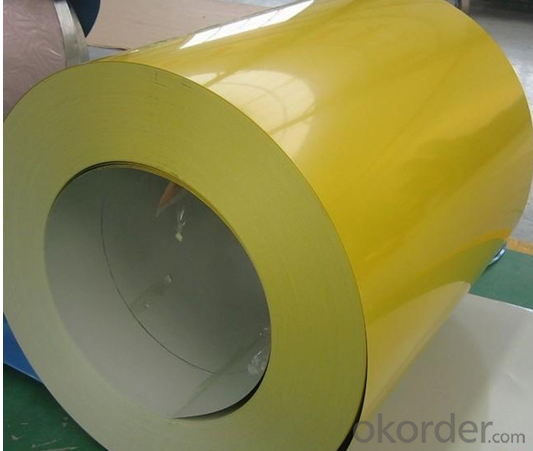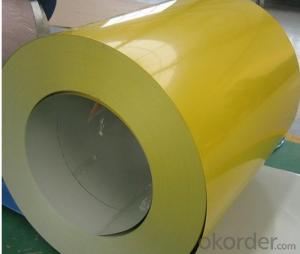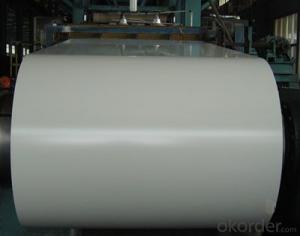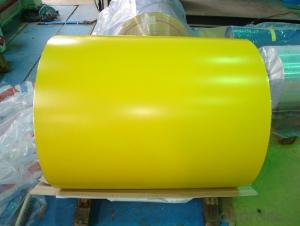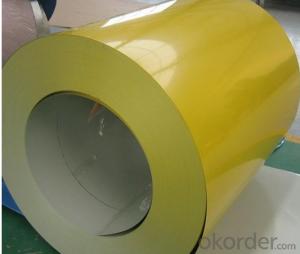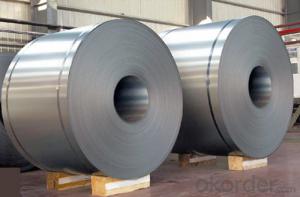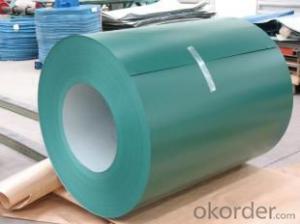PPGI,Pre-Painted Steel Coil Prime Quality in Yellow Color
- Loading Port:
- Shanghai
- Payment Terms:
- TT OR LC
- Min Order Qty:
- 200 m.t.
- Supply Capability:
- 20000 m.t./month
OKorder Service Pledge
OKorder Financial Service
You Might Also Like
1.Structure of Pre-painted Galvanized/Aluzinc Steel Coil Description
With GI (aluzinc) as base metal, after pretreatment (degrease and chemical treatment) and liquid dope with several layers of color, then after firing and cooling, finally the plate steel is called pre-painted galvanized (aluzinc) steel. Pre-painted galvanized steel is good capable of decoration, molding, corrosion resistance. It generally displays workability, durability and weather resistance.
2.Main Features of the Pre-painted Galvanized/Aluzinc Steel Coil
• Excellent corrosion resistance
• Excellent weather resistance
• Capability of decoration, molding, corrosion resistance
• Workability, durability
• Excellent heat resistance performance
• High strength
• Good formability
• Good visual effect
3.Pre-painted Galvanized/Aluzinc Steel Coil Images
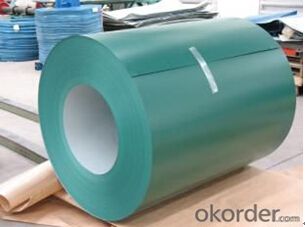
4.Pre-painted Galvanized/Aluzinc Steel Coil Specification
Quality standar: JIS G3312 CGCC & CGLCC
Hardness of P: Both soft and hard quality are available
Surface finish: with or without protect film
Thickness : 0.14-1.20 mm
Width : 914mm, 1000mm, 1220mm and 1250mm, thickness 600-1250mm is available
Finish by coil or sheet: Both sheet and coil are available
8Zinc coating: 60-275G/M2, both sides
Paint thickness for top side : 5 micron primer + (10-20) microns modified polyester, green color.
Paint thickness for back side: (5-10) microns Epoxy
Weight per coil: 4-6 tons, also can be upon customer's requirements
Max loading weight in one 20ft container : 25 tons generally
5. FAQ of Pre-painted Galvanized/Aluzinc Steel Coil
We have organized several common questions for our clients,may help you sincerely:
1. What is the minimum order quantity ?
Our MOQ is 50mt for each size. And we will consider to give more discount if you make big order like 1000 tons and more. Further more, the more appropriate payment term your offer the better price we can provide.
2. How long can we receive the product after purchase?
Usually within thirty working days after receiving buyer’s advance payment or LC. We will arrange the factory manufacturing as soon as possible. The cargo readiness usually takes 15-25 days, but the shipment will depend on the vessel situation.
3. How to guarantee the quality of the products?
We have established the international advanced quality management system,every link from raw material to final product we have strict quality test;We resolutely put an end to unqualified products flowing into the market. At the same time, we will provide necessary follow-up service assurance.
- Q: Can steel coils be coated with QR codes?
- Yes, steel coils can be coated with QR codes.
- Q: Can steel coils be welded together?
- Yes, steel coils can be welded together. Welding is a common method used to join steel coils, where the edges of the coils are heated and fused together to create a continuous and strong joint.
- Q: Are steel coils resistant to rust and corrosion?
- Yes, steel coils are resistant to rust and corrosion. Steel coils are typically made from carbon steel or stainless steel, both of which have excellent corrosion resistance properties. Carbon steel coils are often coated with a protective layer, such as zinc or a polymer coating, to enhance their resistance to rust and corrosion. Stainless steel coils, on the other hand, are inherently corrosion-resistant due to the presence of chromium, which forms a protective oxide layer on the surface of the steel, preventing rust and corrosion. However, it is important to note that the level of resistance to rust and corrosion may also depend on the specific grade and quality of the steel used in the coils, as well as the environmental conditions they are exposed to.
- Q: i wanna buy a sharp carbon steel sword the swords i want are a 200 layer carbon steel katana or a hand forged high carbon steel katanna or a hand sharpened sword which one would be sharper/stronger
- Is Carbon Steel Strong
- Q: it has 2 be 20 inches overall, and 2and1/2 inches wide and .25 or more inches thick... im thinking truck steel but im not sure thx
- Well okorder /
- Q: How do steel coils contribute to the energy sector?
- Steel coils contribute to the energy sector in various ways. Firstly, steel coils are used in the manufacturing of equipment and infrastructure that is essential for energy production and distribution. For example, they are used in the construction of power plants, transmission towers, and pipelines. These structures require strong and durable materials, and steel coils provide the necessary strength and reliability. Moreover, steel coils play a crucial role in the renewable energy sector. They are used in the production of wind turbines and solar panels. Wind turbines require steel coils for their towers, while solar panels use steel frames to provide support and durability. As the demand for renewable energy sources continues to grow, the use of steel coils in this sector is expected to increase as well. Furthermore, steel coils are used in the production of electrical transformers. Transformers are vital components in the energy sector, as they facilitate the transmission and distribution of electricity. Steel coils are used to create the core of the transformer, which is responsible for the efficient transfer of electrical energy. The quality and reliability of the steel coils used in transformers are essential to ensure the smooth functioning of the electrical grid. In addition to their direct applications, steel coils also contribute to the energy sector indirectly. Steel is a recyclable material, and the recycling process consumes less energy compared to the production of new steel. By using recycled steel coils, the energy sector can reduce its carbon footprint and contribute to a more sustainable and environmentally friendly energy production process. Overall, steel coils are a vital component in the energy sector. They are used in the manufacturing of equipment and infrastructure, including power plants, transmission towers, wind turbines, solar panels, and electrical transformers. Additionally, the recyclability of steel contributes to the sustainability of the energy sector.
- Q: Can I ever get my classical guitar reinforced so it can have steel strings on it?
- describes the differences in construction of classical nylon string guitars and steel string guitars--like I said, it would involve reconstruction of more than just a neck
- Q: Is there any way to melt steel without the intense heat of a blast furnace?
- So unless you have a large anount of steel in a large oven and meticulous process control including chemical sampling, your product will end up looking like a piece of iron age metal. But if all you want is to see steel melt, any old blowtorch will do the job. The metal at the end of the process will be useless for pretty much any technical purposes, though.
- Q: How are steel coils tested for dimensional accuracy?
- Steel coils are tested for dimensional accuracy through various methods such as measuring their width, length, thickness, and diameter using specialized tools like calipers, micrometers, or laser measurement systems. These measurements are compared against the specified tolerances provided by the manufacturer to ensure that the steel coils meet the required dimensional standards.
- Q: What are the common transportation defects in steel coils?
- Steel coils can experience various transportation defects. Improper handling or securing during transportation is a major cause of coil damage, resulting in dents, scratches, or tears in the steel. Coil edge damage is another issue that arises when the coils lack proper protection or rub against each other during transit, leading to deformation or breakage of the edges. Additionally, coil shifting occurs when the coils are inadequately secured or braced, causing them to move and shift during transportation, potentially causing misalignment or damage. Moreover, coil corrosion is a prevalent defect that arises when the coils are exposed to moisture or corrosive elements during transportation, leading to rust and deterioration of the steel. To prevent these common transportation defects in steel coils, it is essential to implement appropriate handling, securing, and protection measures.
Send your message to us
PPGI,Pre-Painted Steel Coil Prime Quality in Yellow Color
- Loading Port:
- Shanghai
- Payment Terms:
- TT OR LC
- Min Order Qty:
- 200 m.t.
- Supply Capability:
- 20000 m.t./month
OKorder Service Pledge
OKorder Financial Service
Similar products
Hot products
Hot Searches
Related keywords
